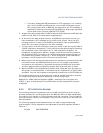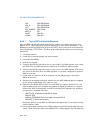
8-30 Vol. 3
MULTIPLE-PROCESSOR MANAGEMENT
SVR EQU 0FEE000F0H
APIC_ID EQU 0FEE00020H
LVT3 EQU 0FEE00370H
APIC_ENABLED EQU 0100H
BOOT_ID DD ?
COUNT EQU 00H
VACANT EQU 00H
8.4.4.1 Typical BSP Initialization Sequence
After the BSP and APs have been selected (by means of a hardware protocol, see
Section 8.4.3, “MP Initialization Protocol Algorithm for Intel Xeon Processors”), the
BSP begins executing BIOS boot-strap code (POST) at the normal IA-32 architecture
starting address (FFFF FFF0H). The boot-strap code typically performs the following
operations:
1. Initializes memory.
2. Loads the microcode update into the processor.
3. Initializes the MTRRs.
4. Enables the caches.
5. Executes the CPUID instruction with a value of 0H in the EAX register, then reads
the EBX, ECX, and EDX registers to determine if the BSP is “GenuineIntel.”
6. Executes the CPUID instruction with a value of 1H in the EAX register, then saves
the values in the EAX, ECX, and EDX registers in a system configuration space in
RAM for use later.
7. Loads start-up code for the AP to execute into a 4-KByte page in the lower 1
MByte of memory.
8. Switches to protected mode and insures that the APIC address space is mapped
to the strong uncacheable (UC) memory type.
9. Determine the BSP’s APIC ID from the local APIC ID register (default is 0), the
code snippet below is an example that applies to logical processors in a system
whose local APIC units operate in xAPIC mode that APIC registers are accessed
using memory mapped interface:
MOV ESI, APIC_ID; Address of local APIC ID register
MOV EAX, [ESI];
AND EAX, 0FF000000H; Zero out all other bits except APIC ID
MOV BOOT_ID, EAX; Save in memory
Saves the APIC ID in the ACPI and MP tables and optionally in the system config-
uration space in RAM.
10. Converts the base address of the 4-KByte page for the AP’s bootup code into 8-bit
vector. The 8-bit vector defines the address of a 4-KByte page in the real-address


















